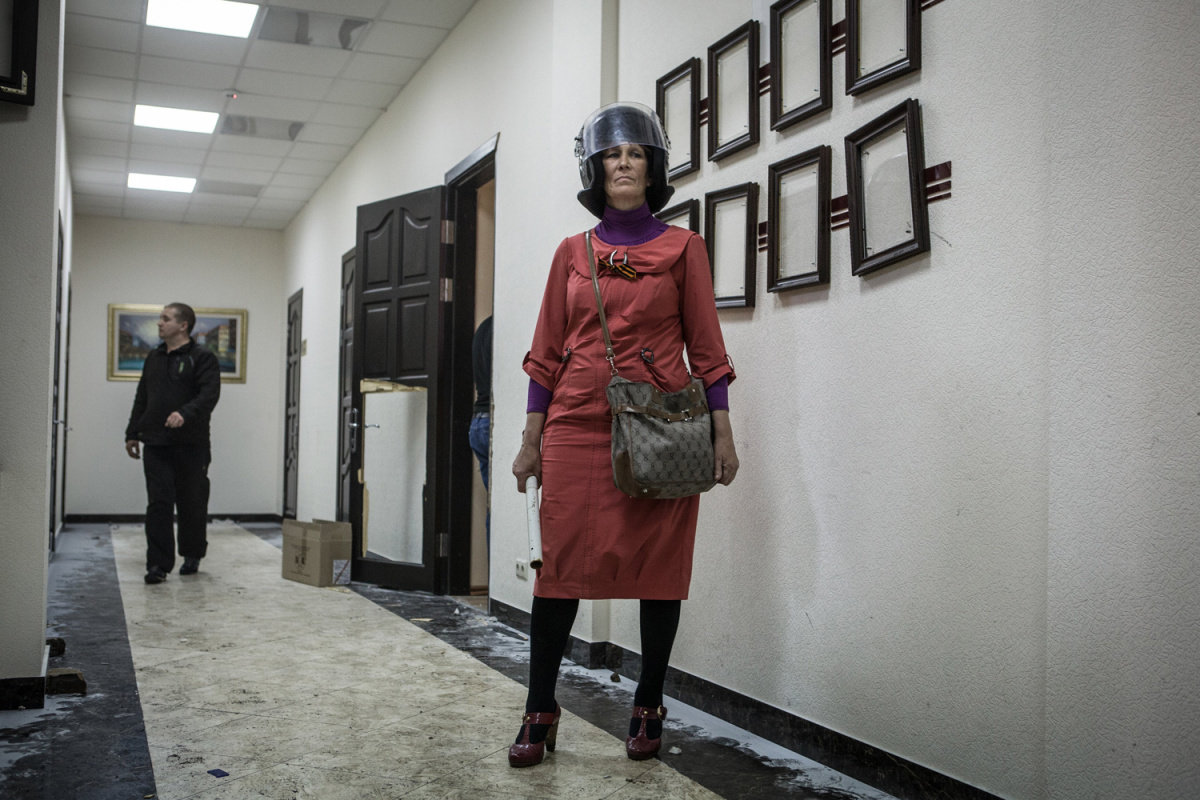Welcome to Donetsk, Ukraine, May 1, 1984.
Technically, it’s 2014. She is one of the pro-Russia activists who had just taken over this government building. She is wearing a riot police helmet. I’m not sure what she is holding, but if it isn’t a club, it certainly could double as one. Her face is a hard as that helmet, which may be why her brutalist clothing and the institutional decor appear so Orwellian.
Of course, we haven’t see the mise en scene of 1984, save in our imaginations, but now we know what it looks like. And like the historical discontinuity of the book’s title–which is behind and yet still ahead of the present–the photo also seems to be the product of a strange temporal warp. Consider how the scene is not perfectly consistent: for example, her contemporary knock-off of a high fashion purse sits uncomfortably with that Soviet-era orange sack of a dress. The guy behind her looks like an ordinary dude looking for an office where he can take care of some mundane task such as getting a license, which would be fine except that the lower half of door to his left has been demolished. The flooring looks nice in the middle of the corridor–which should get the most wear–but looks degraded along the wall, and it’s unclear whether that’s due to the ordinary condition of the building or its seizure and occupation. We can almost imagine that two figures in the photo are in the same place but from completely different moments in time. Or consider that they could stand for a characteristically modern life in 1984, the year in ordinary time, and in 1984, the dystopian novel.
What is interesting about the troubles in the Ukraine is that these and many other historical alternatives all seem to be present. Any number of past dispensations, resentments, and fantasies are tangled up with any number of possible futures, and no one seems to know what is likely to prevail. Take your pick: revanchism, anti-Semitism, European union, Russian empire, democracy, oligarchy, kleptocracy, failed state, 21st century federalism, World War III. . . . And take another look at the photo: her face suggests that now it’s time to settle old scores, but she may be taking a longer view instead. Whatever the decision, the one thing that seems sure is that it will be harsh.
In the current New York Review of Books, Tim Judah remarks that Ukraine is in “that strange pre-war moment whn the possible future overlaps with the present.” Not to take anything away from his emphasis and insight regarding the specific situation, but the present always overlaps with possible futures. The genius of photography is that it can capture how possible future paths are already present, already available to some degree, and real enough that their traces already appear on the surface of things.
Some photographs do that better than others, and that is why I found the image above to be stunning. I think it captures Judah’s specific insight: that is, that in the Ukraine today may be a particularly tangled and unstable example of historical contingency, a moment when many futures are present–those of the past that still are striving for realization and many others as well. It is a moment of extreme futurity, when the present is an inchoate palimpsest of alternatives, some having more power than others but all of them up for grabs.
Which is why the photograph is so disturbing. Surreal juxtapositions (helmet and dress, history and fiction) are one thing, but the will to power is another. If the photo is prophetic, it suggests that in a time where anything can happen, the advantage might lie with those who are single-minded, ruthless, and willing to degrade themselves in order to dominate others.
Welcome to Donetsk, Ukraine, May 1, 1984.
Photo by Sandro Maddalena/NurPhoto/Sipa USA.

Discussion